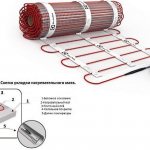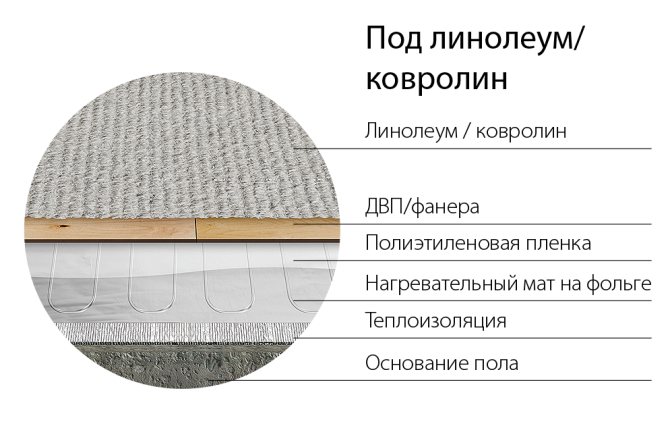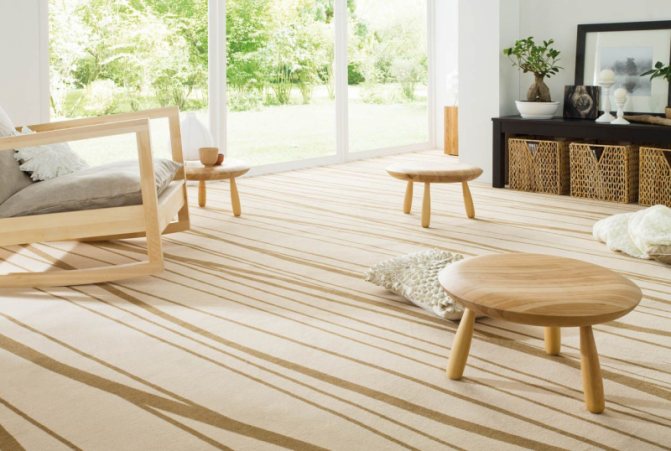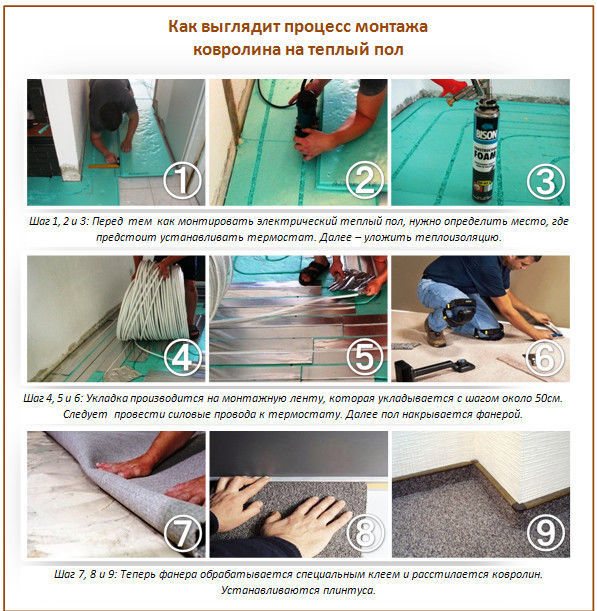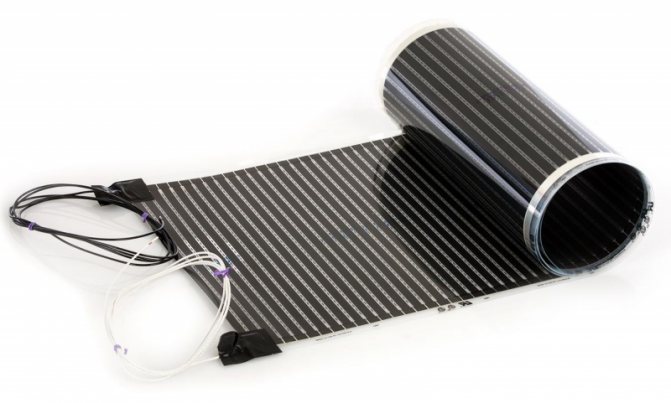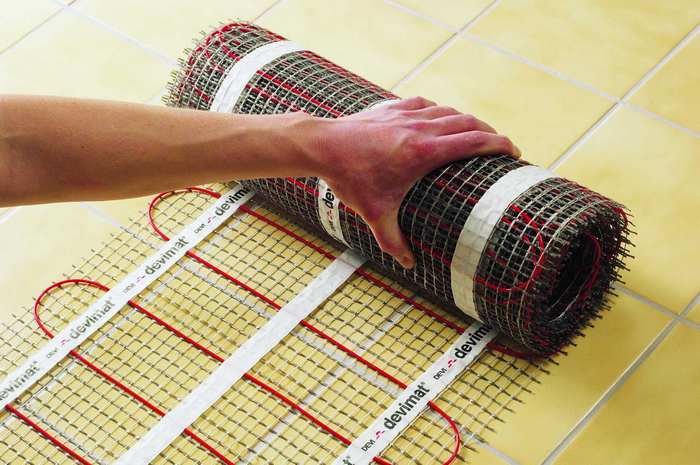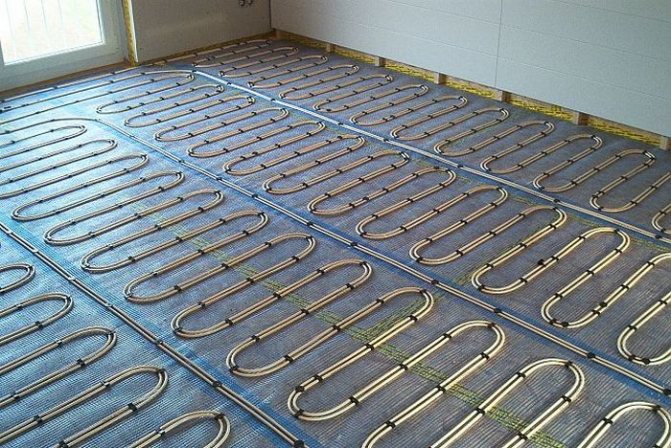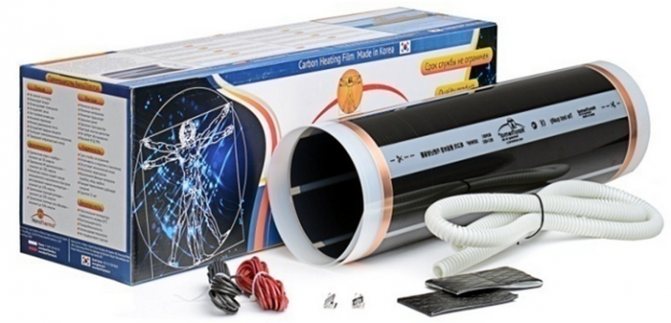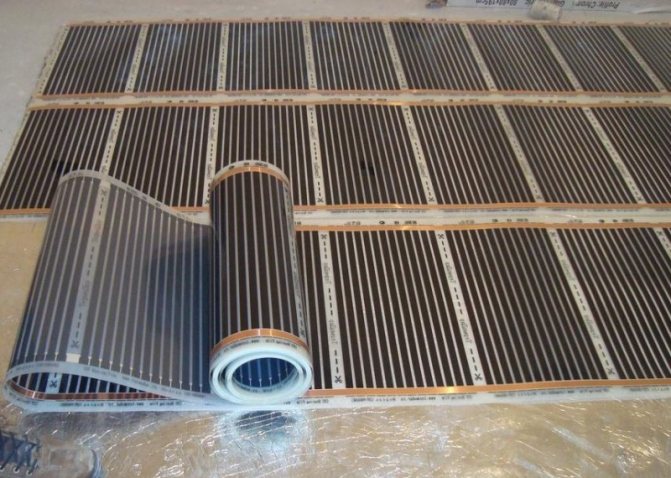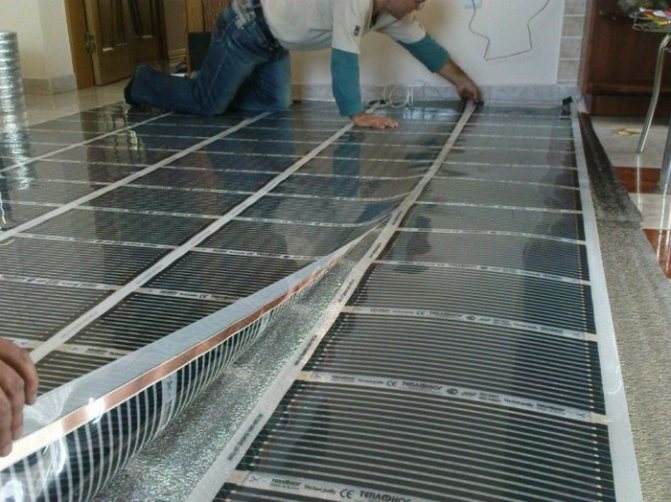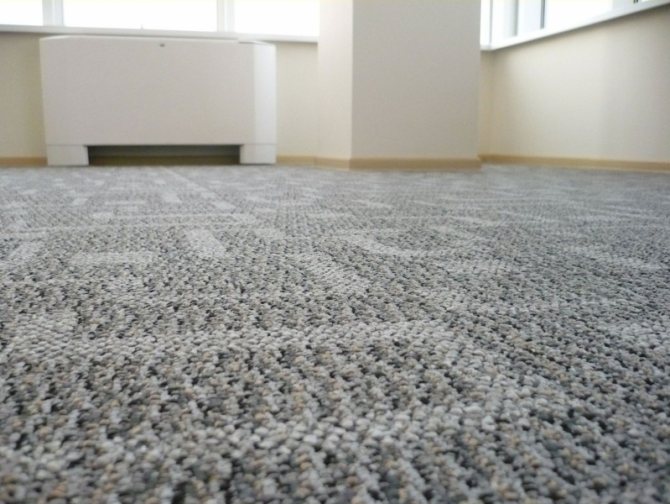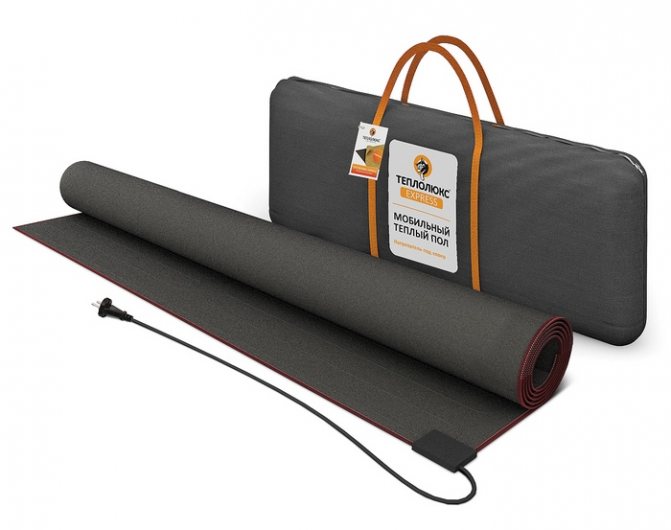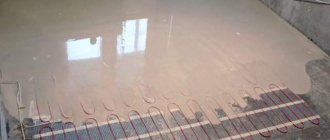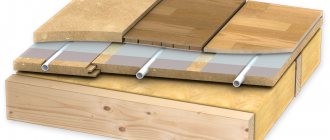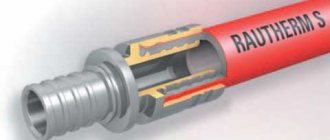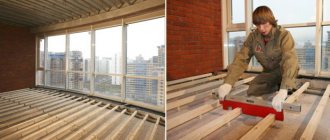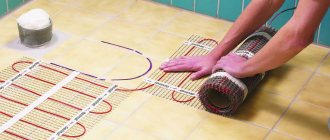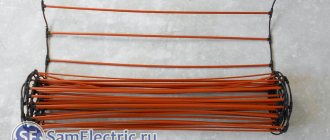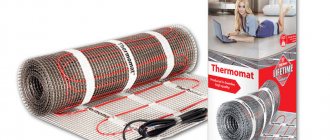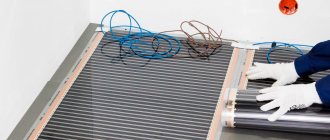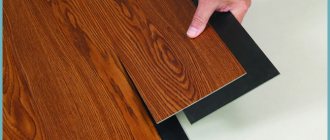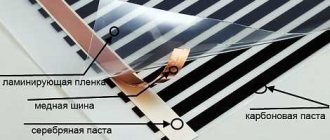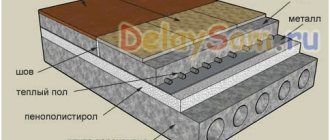What is the difficulty
Carpet is a common floor covering, but when used in a floor heating system, a number of questions arise, since it is a good heat insulator. There are fears that heat will accumulate under the covering, without heating the room to the required degree.
Infrared film warm floor
Experts recommend to correctly select the type of material, as well as provide an insulating layer with a heat-reflecting surface during installation. In this case, the heating system will function efficiently. The advantage of long-pile carpet is the fact that it additionally retains heated air, which allows children to play on the floor without fear of catching a cold. There are two types of similar material:
- shaggy with the effect of homemade coarse yarn, characterized by abrasion resistance;
- catlup with an interesting texture that creates the effect of a multi-level surface.

Step-by-step instructions for laying carpet on a warm floor
Pros and cons of an electric heating system
Considering the electrical type of underfloor heating, it can be noted that it occurs in the form of a cable that requires laying according to a specific scheme, or a heating mat ready for installation.
There are several of its advantages for such a topcoat as carpet:
- uniform heating, which helps to maintain the integrity of the coating;
- the ability to regulate the optimum temperature for the carpet (≤ 30 ° C);
- simple installation.

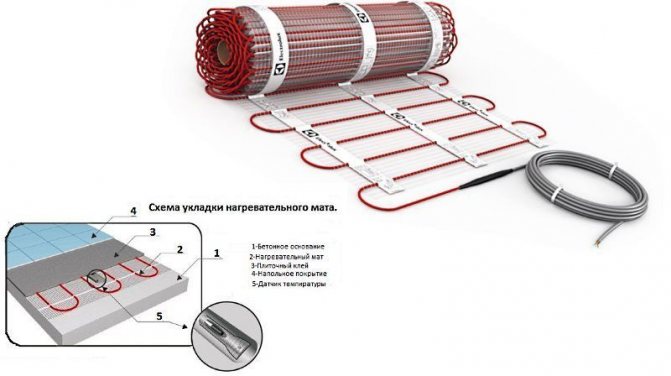
Heating mat laying diagram
Among the shortcomings, there is the possibility of the appearance of overheating zones in the areas under the furniture, which negatively affect the quality characteristics of the carpet.
Installation of cables and heating mats
Choosing a warm floor under the carpet from the range of electrical systems, it is necessary to carry out all the operations for its installation correctly.
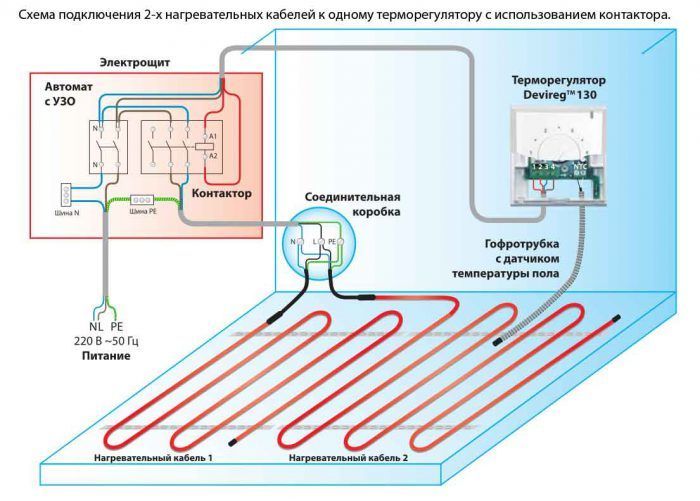

Heating cable system
- Preliminary work is being carried out to level the base and clean it from dirt.
- Thermal insulation is spread over the prepared surface. It is recommended to use versions with a heat-reflective topcoat.
- According to the previously developed scheme, the cable is laid out and fixed.

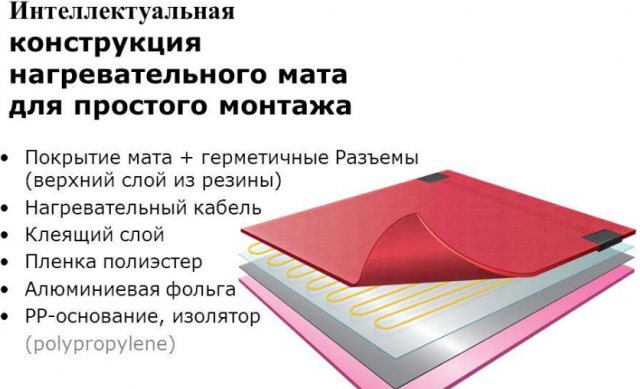
Intelligent heating mat design for easy installation - Steps are taken to connect it to a temperature sensor and a thermostat.
- The screed is in progress. Its optimum thickness is 50 mm. So that subsequently the carpet lies perfectly evenly, the cement-sand surface is ironed.
- To fix the carpet around the perimeter, double-sided tape or special glue is used.
Heating systems for carpet: what are they?
Today's market offers an impressive variety of ways with which you can provide yourself with underfloor heating at any time of the year. The most popular at the moment:
- water floors;
- infrared floors;
- electric floors;
- film.
Each of them has a number of disadvantages and advantages that should be discussed.
Water floors under the carpet
Water floors are a classic solution ideal for private homes. The undoubted advantages of such a system are:
- the possibility of gradual warming up;
- wide threshold for maximum temperature;
- lack of zones with high temperatures.
In fact, a water heat-insulated floor under a low quality carpet is a wonderful way out of the situation. The disadvantages of this type include the high cost and the inevitable rise in the floor level. On average, such a system eats up to 15 centimeters in height.It is also important to mention that such heating will most likely be impossible in apartments, as it can provoke problems in the entire heating system of an apartment building.
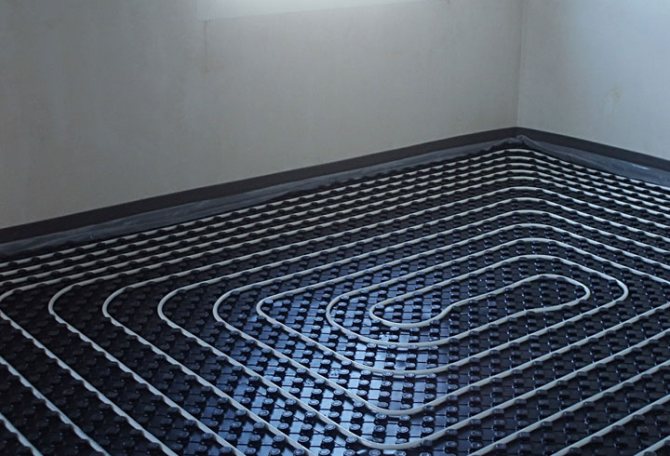

Laying polypropylene pipes with a snail
Installation of such a floor is quite simple: a system of pipes is held along the floor, through which warm water will flow. The methods of laying the pipes themselves are different:
- spiral;
- snake;
- snail.
It is selected based on the characteristics of the room and its location. It is important to note that this type of heating is great for rooms with walls facing the street. A large number of turns at the outer walls allows you to solve the problem of drafts and uneven heating of the room.
The material of the pipes is also important:
- Reinforced plastic. They are durable and have good thermal conductivity.
- Polypropylene. Durability, excellent flexibility.
- Copper. Excellent thermal conductivity, but corrosive and short-lived.
- Corrugated. Excellent flexibility, impressive durability.
- Crosslinked polyethylene. Flexibility, long service life, resistance to extreme high temperatures.
It is better not to save on it, since a leak or another malfunction in the water floors will lead to the need to destroy part or all of the floor covering to repair the damage.
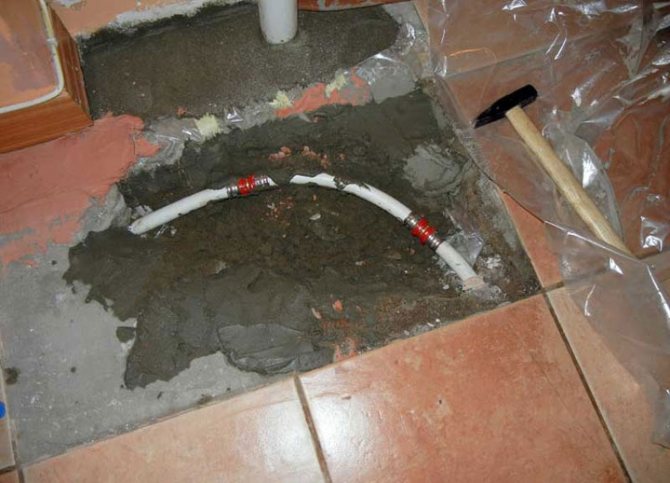

Example of repairing a water floor
Taking into account the heavy and carpet, such repairs will be very expensive.
Electric underfloor heating system
Another classic way to get a warm floor under the carpet is electric. It is a special cable that provides surface heating.
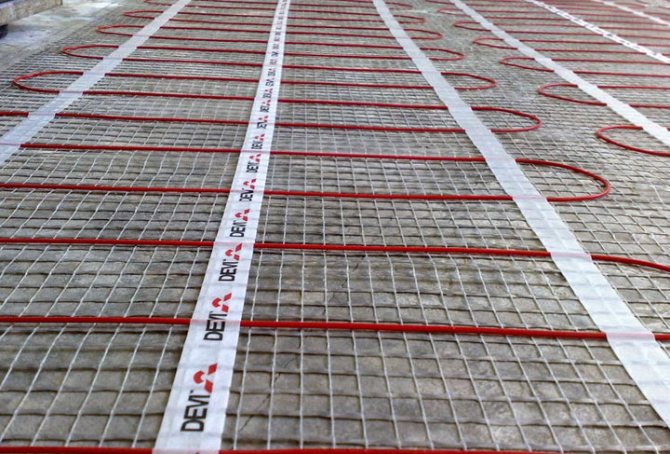

An example of an electric underfloor heating
It is important to note that this type of heating can be used in apartments. The advantages of an electric floor heating include:
- ease of installation;
- strict temperature control;
- uniform heating of the floor.
However, it also has disadvantages. In particular, the electric floor heats up rapidly, which is undesirable for carpet, and there is also a risk of overheating of certain areas (under heavy furniture, for example). In addition, you need to understand that such a warm floor will consume a lot of electricity.
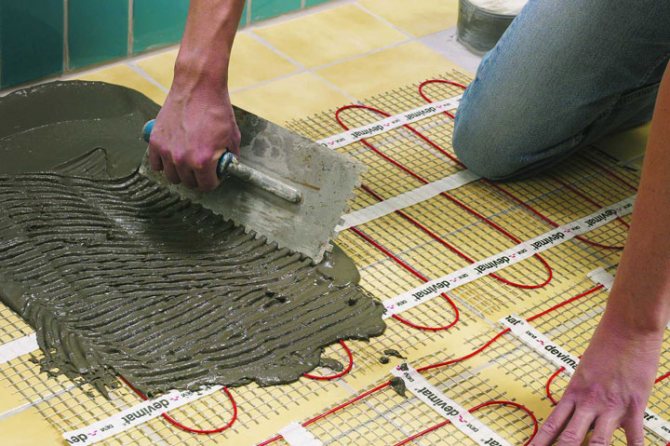

Installation of electric underfloor heating
The installation of electric floors itself is simple: a special mesh with a cable is laid on the prepared heat-insulating base, after which the structure is poured with a special solution - a screed. Unlike a water floor, an electric floor eats up much less from the height of the room, which is important for small apartments.
Infrared floor heating
Infrared underfloor heating under the carpet is relatively new on the market, but has already gained popularity. This demand is driven by a number of characteristics:
- the possibility of uniform heating of the floor;
- strict temperature control;
- high fire safety;
- the risk of carpet overheating is minimal.
It is important to note that, unlike an electric floor, infrared uses significantly less electricity.
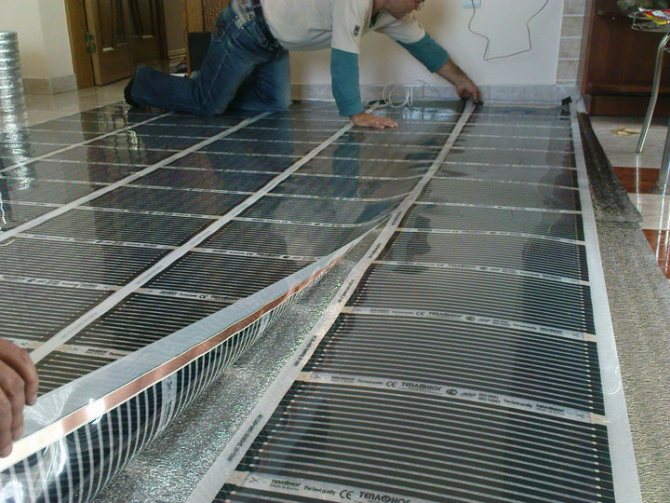

Infrared floor installation
The technology of laying an infrared underfloor heating under a carpet is no different in principle from installing an electric floor, except that a heat-insulating coating under the underfloor heating system is not necessary. Also, there is no need for a screed - this significantly simplifies the entire installation process and saves a lot of space. Installation of an infrared warm floor under a carpet can be done even by an inexperienced person.
Film heating system for carpet
Film underfloor heating under the carpet is a great alternative if it is not possible to overhaul the heating system. In fact, this type of underfloor heating is a mobile module that can be carried to any room.Most often it is located in local areas under carpets, but in some cases it is placed under a laminate.
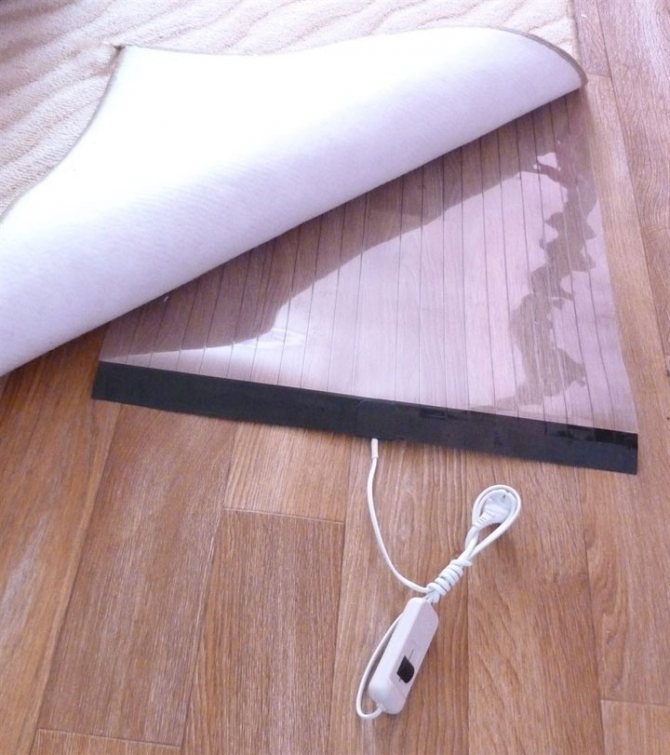

An example of using film underfloor heating
Film underfloor heating under a carpet or carpet is an excellent solution for a number of reasons:
- mobility;
- complete control over temperature;
- exclusion of damage to carpets;
- insignificant electricity costs.
In addition, the installation of a film warm floor under the carpet is quite simple and does not require any preliminary work on leveling the surface or laying.
Distinctive features of infrared heating
Infrared radiation is recognized as the most effective heating method, surpassing its electrical counterpart in many respects.
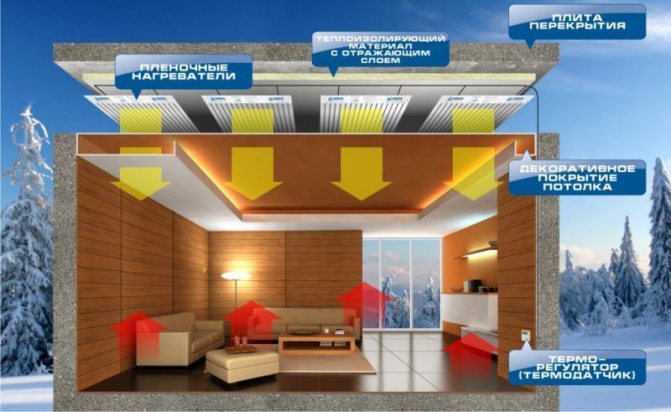

Features of infrared heater
- The carpet does not deform due to its slow and uniform heating.
- When exposed to infrared rays, practically no overheating of the flooring occurs.
- Less power consumption.
- Fast, easy-to-do assembly.
Since the infrared film does not require the arrangement of the screed, the floor level rises slightly, practically without reducing the overall height of the room. This circumstance determines the launch of the warm floor into operation immediately after the end of all work, since there is no need to wait until the screed gets stronger.
Infrared heater
Carpet on a warm water floor
Water heat-insulated floor - a pipeline located under the screed. A coolant water flows through it and heats the finishing floor covering. This system has the highest efficiency and can be used for carpet.
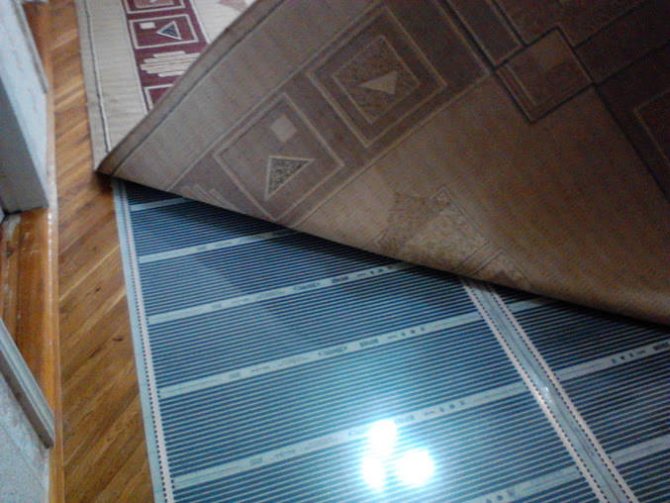

Underfloor heating with a water circuit cannot be installed in city apartments. However, it is the best option for private homes.
Such floor heating is quite difficult to install. Without certain practical skills, it will not be possible to install such a system on your own. Indeed, in addition to complex installation work, it requires the correct connection to the water supply.
Advantages of a water-type underfloor heating:
- A water-type underfloor heating system heats up the flooring gradually. This is extremely important for carpets, especially of questionable quality.
- Hot water underfloor heating does not create hot spots. Thanks to this, the carpet does not deform and does not burn out.
- Underfloor heating is a fairly economical system. In this case, the coolant can be heated by both gas and electricity.
Despite a fairly large list of advantages, a water-heated floor has its drawbacks. Because of this, it is not very popular.
Disadvantages of underfloor heating:
- Installation of such a warm floor is quite difficult. It can only be produced by a qualified craftsman.
- The warm floor of the water type "steals" the height of the room. Due to the verbosity of the installation and the size of the pipes, the floor rises by 10-15 centimeters.
Water heat-insulated floor is suitable for carpet. However, the complexity of its installation scares away many ordinary people.
Arrangement of the film floor
When installing an infrared warm floor under the carpet, you should start with the acquisition of the necessary equipment, including a heating film, installation wires, thermal insulation with a foil surface layer, and a thermostat.
The installation of a warm floor itself consists of several stages.
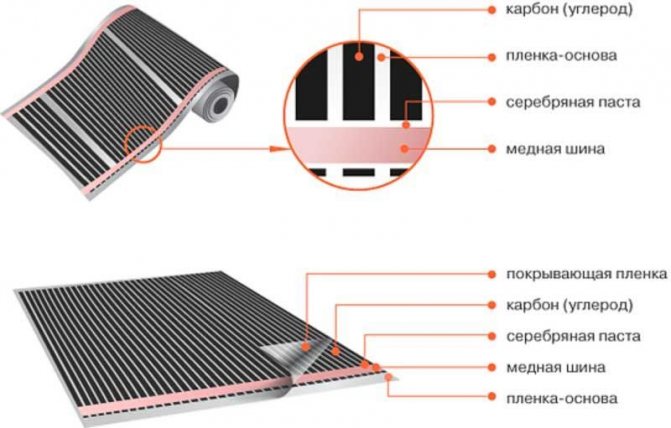

Film floor device
- Cleaning, and if significant defects are found, leveling the base.
- Arrangement of thermal insulation with sealing joints with adhesive tape.
- Laying the film cut along special lines, excluding the overlapping of stripes.
- Connection of wires with insulated contacts.
- Connecting them to a thermostat.

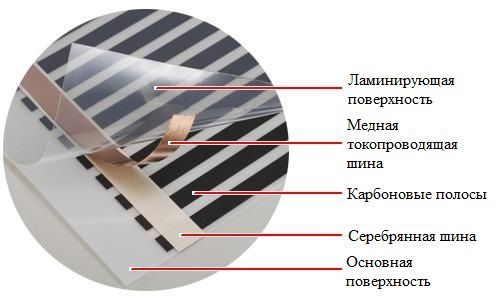
The structure of the film underfloor heating - Installation under the film of a temperature sensor with a wire leading to the temperature regulator.
- Plugging into the network for performance check.
- Laying moisture-resistant plywood on a pre-laid waterproofing film.
- Carpet flooring with tape fixation. You can use special glue.
It should be borne in mind that if the electric floor can be mounted almost over the entire plane, then the infrared analog is not recommended to be laid under furniture.
Underfloor heating technology
Regardless of the type of floor heating chosen, the installation process of the heater consists of three stages:
- Surface preparation and installation of insulation;
- Installation of heating elements, connection to an energy source;
- Laying the outer covering and rolling the carpet.
The flooring is usually chosen based on the characteristics of the carpet. Most often these are sheets of plywood, fiberboard, linoleum, any material on which carpet can be laid without risk. If you plan to pour a water-heated floor, then it is better not to lay the carpet on concrete, you will need to additionally sew on fiberboard or OSB.
Installation of a warm water floor
A serious disadvantage of using hot water for underfloor heating is the need to equip the screed. It is impossible to simply lay a pipe, even a polyethylene one, on concrete and close it with plywood, laminate or any other floor covering, even if there is a carpet on top. First, it will reduce heat transfer by several times. The amount of heat given off by the pipe will decrease to 15-20%. Secondly, the pressure from the weight of the furniture and residents will over time simply crush the polyethylene pipe, even if the system is laid in a reinforcement bag.
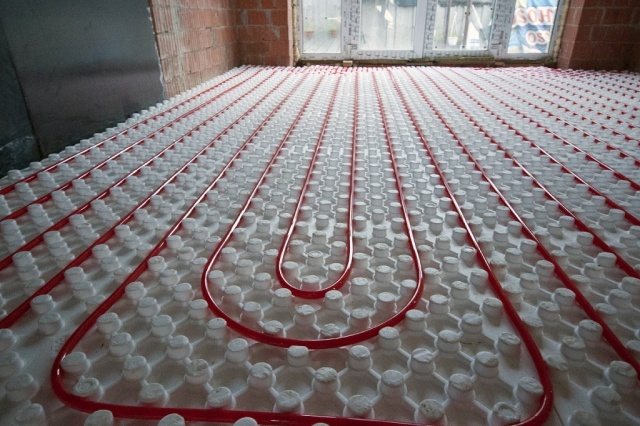

Pipes are laid on a reinforcing base
Structurally, the installation is carried out as follows:
- Fiberglass reinforcement is mounted on the prepared surface;
- Next, a polyethylene pipe is laid out in a spiral or zigzag stripes;
- The inlet and outlet are connected to a heating system or to a water tank. After that, the tightness of the warm floor is checked at low fluid pressure;
- The laid structure is poured with a cement-sand screed.
- After the poured mixture has set, it is also checked using a vacuum or, more often than not, simply by leaving the warm floor under the pressure of cold water for several hours.
For your information! Experts recommend checking the condition of the base under the carpet at the beginning of each heating season.
Water leakage can be small, and the carpet material is able to slowly and imperceptibly absorb liquid, so the covering is removed and the floor is inspected for cracks or wet spots. Sometimes the owners of the apartment put plastic wrap under the carpet, this saves them from getting wet, but seriously reduces the heat transfer of the warm floor.
Installation of film underfloor heating
Assembling the water system requires a lot of effort, but the preparation of the concrete base is not particularly difficult, just sweep the floor thoroughly. In the case of using a film heater, the surface is not only cleaned, it is washed and dedusted in order to surely remove "grains" and small stones.
The second stage is the installation of thermal insulation. Usually it is foil insulation based on polyethylene foam. The material is rolled in the same direction in which the carpet will be laid. Separate sheets are leveled and glued with ordinary tape.
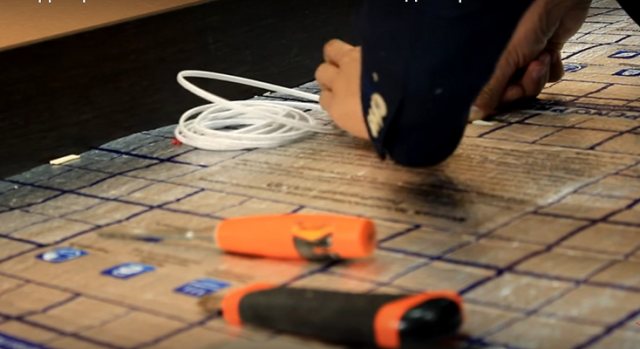

To prevent the wire from sticking out through the carpet, it is recessed into the substrate
Next, you need to lay the film heater. Usually, these are tapes 1 m and 0.5 m wide. With wide tapes, he spreads the main part of the floor on which the carpet will be laid. The remaining areas are filled with narrow panels, for example, at the entrance or at the places where furniture is installed, where there will definitely not be a carpet.
The rolled films are carefully aligned, making sure that there are no overlaps and large gaps at the joints.The material is glued to the floor with special heat-resistant stickers. They are thin and do not stick out through the carpet. To connect a warm floor, the canvas is cut off from the side of the contact track, the connectors are installed and, with the help of special pliers, the sleeves are latched onto the copper pads.
Each such canvas is connected by two conductors. After installing the wiring and connecting to the regulator, check the serviceability of the warm floor. At the same time, the temperature is set, it should be high enough for comfortable heating of the room, but not exceed the resistance threshold of the carpet.
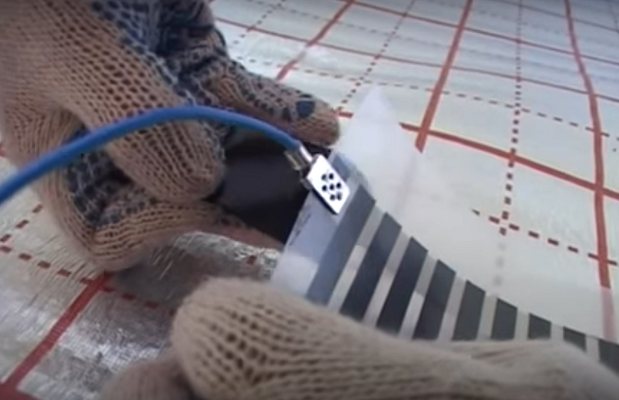

Contacts must be crimped with pliers
At the final stage, graphite heaters are covered with plastic wrap, which is fixed with brackets around the perimeter of the room. In order to be able to lay the carpet, fiberboards or linoleum are overtaken on top.
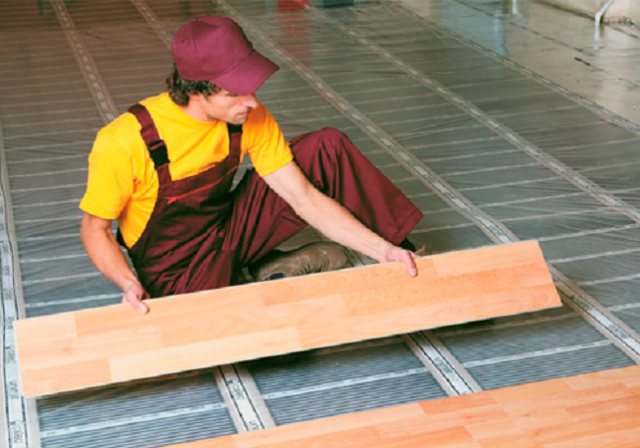

It is imperative to lay an intermediate floor under the carpet.
Mobile floor
A convenient option for summer cottages or temporary housing is a mobile warm floor. It is also good if you need to heat the local area in the room.
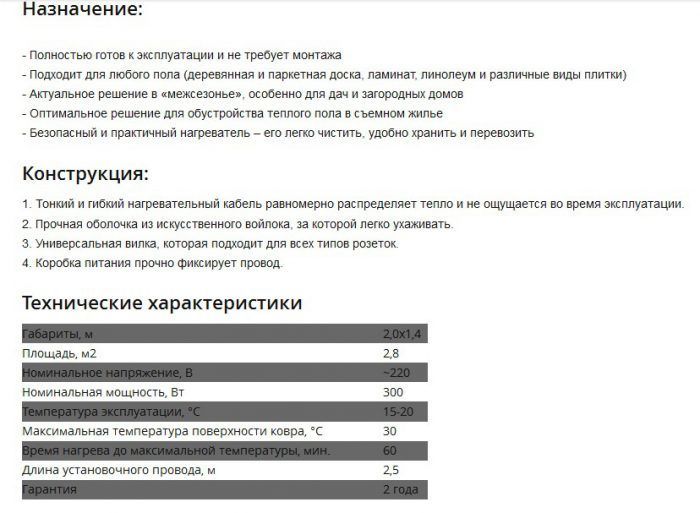

Mobile Warm Field Information
The peculiarity of such infrared models is that the finished warm floor is simply spread over the existing coating - parquet, tile, laminate or the usual linoleum, and then the carpet is laid. Using the supplied cord, the system is connected to the mains.
Among the advantages of this option is the ability to quickly move it if you need to heat another room. Also important is the fact that the installation is accessible to any person. Since automatic regulation of the heating intensity is provided, such a floor is safe and can be used in children's rooms. It is quite economical, which enhances its attractiveness.
Expert advice
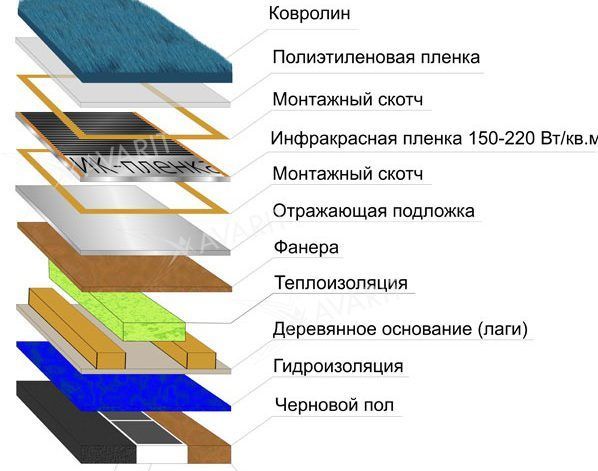

Installation of infrared film under the carpet
An electric or innovative infrared floor can be selected to fit under a carpet that is comfortable for tactile sensations - the solution to this problem depends on their characteristics and the conditions in which the installation will be carried out.
If we take the criterion of ease of installation as a basis, then the preference is given to infrared film floors, which can be mounted within two to three days, including the day necessary for the carpet laid out after transportation to straighten. He doesn't need a screed.
For temporary conditions, mobile options for warm floors are selected. An electric floor under the carpet is practically not recommended due to the possibility of its deformation in the event of possible overheating.
Electric cable floor
Electric heating with the growth of energy efficiency of the proposed solutions is gaining more and more popularity. Even a beginner can handle the installation of a modern twin-core cable. In this case, underfloor heating screeds up to 40-50 mm thick are not required. The cables can be installed in a sufficiently thin layer of tile adhesive.
At the same time, the cable electric underfloor heating is conveniently controlled by an internal heating sensor and an external one - the room temperature. Moreover, if you lay a carpet on such a floor, there will be no difficulties.
The system can be infinitely adjustable. The setup process is much easier than with a warm water floor. The advantages of the cable system include:
- smooth distributed heat release;
- uniform heating of the carpet surface;
- the ability to lay the cable in a layer of tile adhesive.
A cabled electric floor can be created in apartments and houses where the floor load plays a decisive role. He does not need a massive screed. The cable is laid on a thermal insulator on top of a plywood flooring along wooden logs. At the same time, the efficiency of the warm floor is not lower than the classical water system.
Cable underfloor heating has a key drawback that does not allow us to call it the best solution for carpet. If one point of the cable is damaged, the entire structure immediately stops working. Therefore, with the low cost and ease of installation, the electric wire heating system cannot be considered a leader.
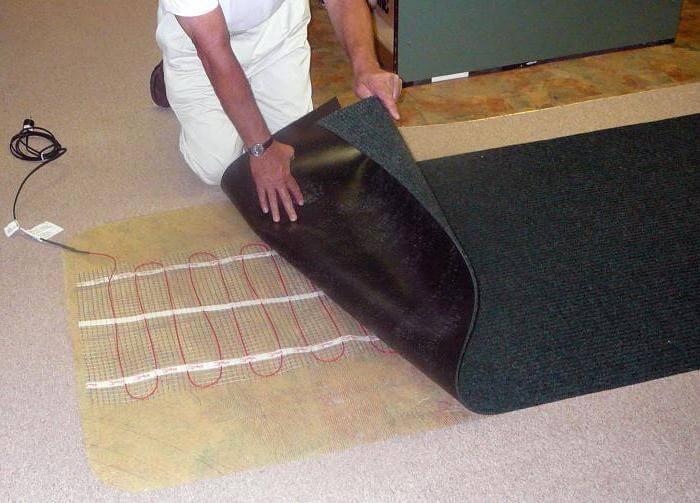

Electric cable for carpet

